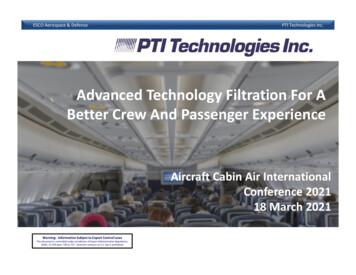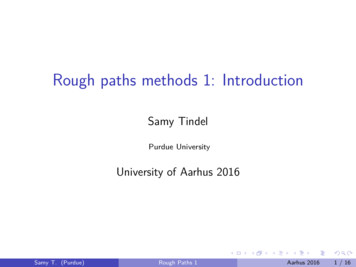Fundamentals Of Granular Media Filtration
FUNDAMENTALS OFGRANULAR MEDIAFILTRATIONGordon Williams, PhD, PEEast Bay Municipal Utility District1
OVERVIEWFiltration basics Filtration theory Filter media selection and design Monitoring and Troubleshooting 2
FILTRATION BASICS ANDTHEORY3
WHAT IS FILTRATION?Definition: any process that removes suspendedparticles through a porous medium Types of Filters yGranular media filters (GMF)Slow sand filters Rapid depth filters yMembrane filters (MF/UF/NF/RO)4
TYPICAL FILTRATION PRE-TREATMENTFiltration NTUConventionalAnyDirect 15NTUContact 10NTU5
A TYPICAL GRAVITY DEPTH GMFComponents Flow control Media Underdrain andsupport Backwash systemPicture from MWH (2005) Water Treatment Principles and Design6
GRANULAR MEDIA TYPESConfiguration Mono media Dual media MultimediaTypes Silica sand Anthracite coal GAC Other (e.g. garnet)7
FILTER UNDERDRAINS AND SUPPORT8
UNDERSTANDING A FILTER RUNRipeningOperating TurbidityBreakthroughTerminal head lossClean bed head loss9Time to breakthrough9
SURFACE VS. RECYCLED WATER FILTRATIONTypicalSurface WaterRecycled WaterDriverssediment,pathogens, organicsolidspathogens,organic solidsPretreatmentAnydirect/contactSource Water1 to 100 NTU1 to 10 NTUTurbidity Req’d0.3 NTU/0.1 NTU2 NTUFiltration Rate(gal/ft2-min)3/6 (mono/dual)5 (up to 7.5)10
11FILTRATION THEORY
FILTRATION THEORY Modeled as 2-step process1.2. Particle transportParticle attachmentParticle transport mechanismsSedimentationy Interceptiony Brownian motion (diffusion)yStraining not desirable Overall removal is sum of allmechanisms Picture from Lawler and Benjamin 200612
PARTICLE TRANSPORT EFFICIENCYTransport efficiencydriven by: Filtration rate Media design Particle size Temperature Density (sed. only)Graph from Lawler and Benjamin 200613
ACTUAL DATA MATCHES UP WITH THEORY!MS2GiardiaCryptoE. ColiFrom Williams 200914
WHY IS CHEMISTRY SO IMPORTANT? Chemistryneeds to be right for particles to “stick” Both particles and media are naturally negativelycharged and thus repelled by each other For excellent filtration, the surface chemistry oftarget particles must be modified – coagulation!15
PARTICLE ATTACHMENT EFFICIENCYAttachment is driven bychemistry Attraction/repulsive forces London-van der Waals forcey Electrical double-layerinteractiony Born repulsive forcey Hydration forceyFrom V. Jegatheesan and S. Vigneswaran(2005)16
17FILTRATION MEDIASELECTION AND DESIGN
HOW DOES THEORY AFFECT DESIGN?Increased media depthIncreased media size18from Lawler and Benjamin 2006
HEADLESS ACROSS FILTER BED19
WHAT MAKES DESIGN GMFCOMPLICATED?Two competing goals:1.Particle removal (i.e., effluent quality)2.Filter run length (i.e., head loss accumulation)Head lossParticleRemoval20
HOW DO WE BALANCE COMPETINGVARIABLES?1 ft2Modifying three basic design parameters Mediaselection Depth of media Filtration rate (flow velocity)In terms of cost Biggest cost driver will be filtration rateyFilter area is function of filtration rate6 gpm21
APPROACH TO MEDIA SELECTIONBegin with good understandingof treatment goals and waterqualityApproaches to Design Followindustry design standards Modeling approach Filter piloting22
SPECIFYING GMF MEDIA Effectivegrain size (d10) Uniformity coefficient(UC)yyyUC d60/d10Smaller the betterTypically 1.5 Mediadepth (L) L/d10 1000 Trends over timeyyDeeper and coarserHigher filtration rates23
DEFINE FILTER MEDIA GOALS Whatyyyydoes better performance mean?Reduce head loss accumulationImprove effluent water qualityReduce risk of breakthroughManage a combination of goals for multiple sourcewaters24
MODELING APPROACH TO MEDIA SELECTIONModel Calibration(historical data) Water quality Chemical use Breakthrough Head loss changesPerformance Modeling(under various conditions) Feed water qualities Media sizes anddepthsMedia SelectionParticleremovalTime tobreakthroughTime toMax. head lossOptimal balance2525
EXAMPLE OF MODELING RESULTS2626
27FILTEROPERATIONS
CLEAN-BED REMOVAL AND RIPENINGSurface chemistry is improved through chemicalconditioning (coagulants and polymers) Particle-particle attachment is more efficient thanparticle-media attachment Ripening needed for excellent removal Typical practice to have a filter-to-waste step 28
FILTER PERFORMANCEMONITORING Turbidity standard performance metricy NTU Nephelometric Turbidity Unity Based on light scattering Particle counters – based on light blockage Surrogate parameter for treatment performance Regulatory limits of 0.3 or 0.1 NTUOld schoolturbidity byJackson candle(JTU)29
30Slide from Ben Stanford, AWWA IPRS 2016, Long Beach, CA
GMF FILTER O&M TROUBLESHOOTINGExcellent influent water quality ease ofoperation Balance turbidity and head loss usingchemical dose Backwash management When issues arise - filter surveillance! yyyyyVisual observationUFRVFilter coring – media changes/mudballsWatch head loss – air bindingBackwash profile – improved sequence31
VirusBacteriaFrom Williams 200932QUESTIONS?Gordon Williams, PhD, PEEast Bay Municipal Water Districtgjwillia@ebmud.com
UNDERSTANDING THE EXISTING MEDIASieve AnalysisFilter Coring of Existing Media33
34
35
36
37
38
Typical Surface Water Recycled Water Drivers sediment, pathogens, organic solids pathogens, organic solids Pretreatment Any direct/contact Source Water 1 to 100 NTU 1 to 10 NTU Turbidity Req’d 0.3 NTU/0.1 NTU 2 NTU Filtration Rate (gal/ft2-min) 3/6 (mono/dual) 5 (up to 7.5) 10
matter what filtration/separation equipment you use or when it was installed, our filtration service personnel provide complete, expert support to maintain the reliability and . Gas Filtration Solutions. Jonell Systems has more than 140 years of combined filtration experience in Oil,
ESCO Aerospace & Defense PTI Technologies Inc. PTI’s Pedigree In Air Filtration Who is PTI Technologies World leader in aviation/aerospace filtration for over 60 years Filtration for all aircraft fluids – hydraulics, air/bleed air, fuel, water, lube Our experience and pedigree in air filtration
Multi-media filters: These have three types of media, usually crushed anthracite coal, sand, and garnet. Water Filtration Filters may be classified according to the types of media used as follows: Water Filtration In water treatment all three types are used; however, the dual- and multi
filtration and separation equipment for industries from Oil & Gas, Power, Chemical and Marine to Water Treatment, Paper/Pulp and General Industry. SPX FLOW’s Filtration and Separation Technology (FaST) group is comprised of 5 leading filtration brands, Airpel / Dollinger / Plenty Filters / P
GAS FILTRATION & SEPARATION Filtration Group. Chemicals Gases Fuels Oils Steam Water Clark-Reliance Filtration Group offers premium-quality, reliable filter elements for all industries. Our liquid and gas
GAS FILTRATION & SEPARATION Filtration Group. Chemicals Gases Fuels Oils Steam Water Clark-Reliance Filtration Group offers premium-quality, reliable filter elements for all industries. Our liquid and gas
Filtration is the separation of particles of solids from fluids (liquid or gas) or liquid from liquid gas mixture by use of a porous medium. This Standard Practice deals only with separation of solids from liquid, i.e., "Liquid Filtration". 1. Mechanisms of filtration Three main mechanisms of filtration are cake f
Samy T. (Purdue) Rough Paths 1 Aarhus 2016 12 / 16. Study of equations driven by fBm Basicproperties: 1 Momentsofthesolution 2 Continuityw.r.tinitialcondition,noise Moreadvancednaturalproblems: 1 Densityestimates, Hu-Nualart Lotsofpeople 2 Numericalschemes, Neuenkirch-T,Friz-Riedel 3 Invariantmeasures,ergodicity, Hairer-Pillai,Deya-Panloup-T 4 Statisticalestimation(H,coeff. V j .






















